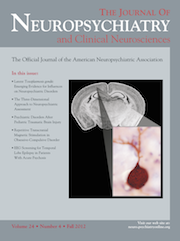Use of Lithium for Sexual Obsessions in Asperger’s Disorder
To the Editor: Obsessional/repetitive behaviors are a core feature of autistic-spectrum disorders. Symptoms suggesting a DSM-IV diagnosis of obsessive compulsive disorder have been reported in 37% of the children with autism.1 Sexual obsessions have been commonly reported in these patients.2
We report on a 17-year-old young man with a diagnosis of Asperger’s disorder who complained of having intrusive sexual thoughts and urges. He was masturbating 25–30 times per day, resulting in penile ulcers. These symptoms were associated with severe anxiety and frustration, leading to suicidal thoughts and self-injurious behavior, including stabbing his penis with tweezers. The patient denied any concomitant mood or psychotic symptoms. He denied any substance use, and his urine toxicology screen was negative. The patient was currently on sertraline 200 mg, clomipramine 225 mg, and aripiprazole 10 mg daily. He has had previous failed trials on citalopram, fluvoxamine, fluoxetine, clonazepam, quetiapine, and risperidone.
Low serotonin levels have been associated with impulsive and aggressive behaviors,3 and enhancement of central serotonin neurotransmission could ameliorate heightened sexual desire and compulsivity associated with such sexual behaviors.4 Lithium has been shown to have some efficacy in similar behaviors associated with obsessive-compulsive features, such as pathological gambling.5 Hence, a trial of lithium was considered in this patient, and the dose was titrated up to 600 mg twice daily, with a lithium level of 0.56 mEq/L. The patient showed significant improvement in his sexual obsessions. He has not had a relapse in his obsessive symptoms and participates in cognitive-behavioral therapy to help with sustained remission.
Lithium is known to increase serotonin levels in the cerebrospinal fluid by inducing serotonin synthesis.6 The particular pro-serotonergic action of lithium could be helpful in reducing the heightened sexual obsession and compulsive behavior. Further double-blind, placebo-controlled studies are needed to confirm the role of lithium as an augmentation agent for treatment of obsessive sexual behaviors.
1 : Comorbid psychiatric disorders in children with autism: interview development and rates of disorders. J Autism Dev Disord 2006; 36:849–861Crossref, Medline, Google Scholar
2 : Repetitive behaviour in children with high-functioning autism and obsessive-compulsive disorder. J Autism Dev Disord 2007; 37:251–259Crossref, Medline, Google Scholar
3 : Fluoxetine and impulsive aggressive behavior in personality-disordered subjects. Arch Gen Psychiatry 1998; 54:1081–1088Crossref, Google Scholar
4 : Serotonergic medications for sexual obsessions, sexual addictions, and paraphilias. J Clin Psychiatry 1992; 53:267–271Medline, Google Scholar
5 : Lithium and valproate treatment of pathological gambling: a randomized, single-blind study. J Clin Psychiatry 2002; 63:559–564Crossref, Medline, Google Scholar
6 : Overview of the mechanism of action of lithium in the brain: fifty-year update. J Clin Psychiatry 2000; 61(Suppl 9):5–15Medline, Google Scholar



